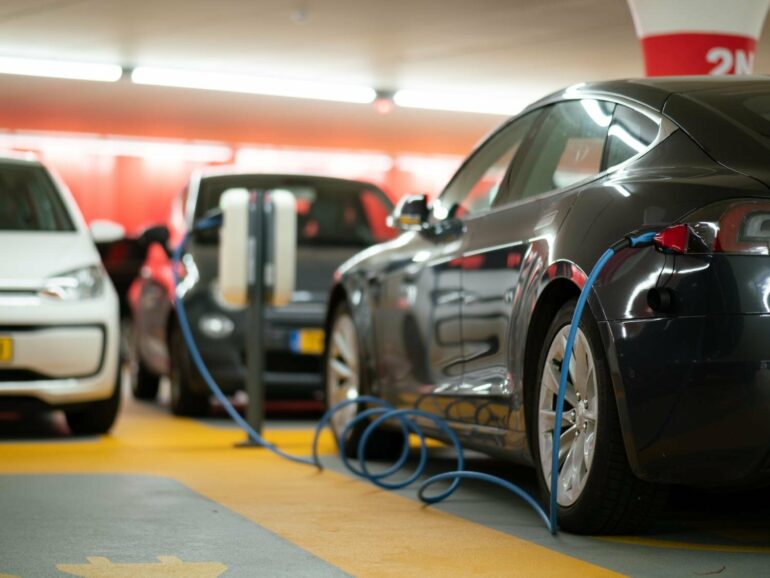Electric vehicles, or EVs, promise to reduce carbon emissions and serve as a tool to help mitigate climate change, but a team of Penn State researchers report there has been little research to determine how equitable the benefits of EVs are and, in fact, whether the technology may unfairly harm some areas and populations.
In a study, the researchers only found 48 papers out of a pool of 9,838 studies that explicitly addressed equity issues of EVs, said Wei Peng, assistant professor of international affairs and civil and environmental engineering, Peng added that the small percentage of papers that addressed equity was telling in itself.
“During that screening process, we began to learn what is overstudied and what is understudied,” said Peng, who is also an associate of the Institute for Computational and Data Sciences. “We highlighted in our paper what we saw as the most understudied: making equity more explicit as research and, second, we saw a need to focus on those emerging markets and parts of the developing world where EVs are going to be more important.”
Unlike vehicles powered by gasoline or diesel fuel, which produce carbon and other chemicals during the combustion process, the electric motors that drive the wheels of an EV do not produce tailpipe emissions. EV owners charge the batteries that are stored on board the EV, rather than add fuel.
While driving electric vehicles may not emit carbon and other gases that could be harmful to people and the environment, there could be other economic and ecological costs that are not readily apparent, according to the researchers, who published their findings in Environmental Research Letters. For example, power plants that create the electricity to charge the vehicles may rely on systems that produce carbon. These plants may also be located long distances from where the electric vehicles are in use.
The researchers added that the electric vehicles themselves require metals and materials that must be mined and manufactured. These materials are often transported through complex supply chains that stretch across the globe.
“As one example, electric cars are often seen as a positive step towards reducing air pollution in urban areas,” said Peng. “However, depending on how the electricity used to charge these cars is generated, it can have unintended consequences. If coal-fired power plants are used to generate the electricity for charging electric cars, then those living near these power plants may suffer from the transition to clean transportation. Additionally, the global supply chain challenges for electric vehicles, such as the need for batteries and steel, raise concerns that maybe we are just shifting emissions and other negative impacts to other countries.”
Vulnerable populations
Little work has been done to understand the makeup of populations that may be vulnerable to those impacts, the researchers report.
“One of the things we need to focus on are the effects for air pollution and, in particular, location specific factors,” said Jinyu Shiwang, doctoral student in civil and environmental engineering. “For example, there is the distribution of social demographic patterns that will influence the exposure and influence the environmental impacts.”
As an example, locations with more older people might be more vulnerable to the health impacts of air pollution compared to places with higher numbers of young people, Shiwang added.
Technologies aimed at improving the environment—often called “clean tech”—are often viewed as universally beneficial. However, the study points toward the need to deeply probe all of possible effects—positive and negative—of these complex technological advances from the lens of equity, said Anna Lee, an undergraduate student in geosciences.
“There is an importance to understanding the intersection between environmental and social issues and also understanding how to better assess equity about the research in a policy setting,” said Lee. “As this study shows, equity is definitely a complex issue that involves better understanding the complex intersections between the transport of power and the manufacturing sector and how these equity implications can greatly differ depending on the geographical location, spatial scale and other social demographic factors.”
Peng, Shiwang and Lee worked with Anjali Sharma, the first author of the paper, who was a postdoctoral researcher in Peng’s lab and is now an assistant professor at the Indian Institute of Technology.
The team conducted the literature review by searching for peer-reviewed papers published in English between January 2010—when EV technology began to rapidly emerge—and August 2022. The researchers included papers that quantitatively assessed the distribution of at least one outcome of interest, such as emissions, pollution or health. They also included papers that studied the impacts across different population groups and locations. However, they excluded papers that did not perform a quantitative assessment of the distribution of emission and/or health impacts.
The researchers suggest two areas for future work. First, more information is needed on the pollution and health impacts at a fine spatial scale, in addition to quantifying the impacts on emissions. There is also a need to understand the links between the transportation, power and manufacturing sectors to better understand the region-specific activities and impacts of the whole EV value chain.
More information:
Anjali Sharma et al, Equity implications of electric vehicles: A systematic review on the spatial distribution of emissions, air pollution and health impacts, Environmental Research Letters (2023). DOI: 10.1088/1748-9326/acc87c
Provided by
Pennsylvania State University
Citation:
More research needed to spread the benefits of electric vehicles equitably, says study (2023, May 15)



